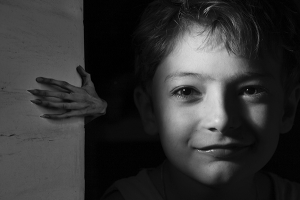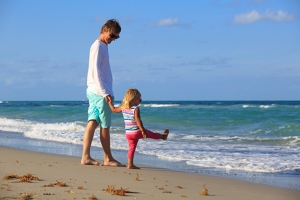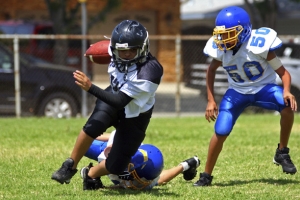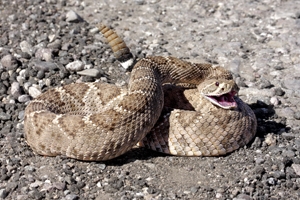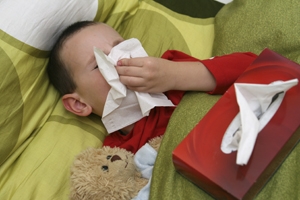
Toxicologists at UCSD Medical Center and the San Diego Division of the California Poison Control System recommend taking a few simple precautions to protect your family against summer stings, bites and bugs.
Snake Bites
In the warm summer months, even beach-loving San Diegans head for the hills for hiking, biking, camping and other outdoor activities.
This region averages 50 to 60 snakebites a year, according to Richard Clark, M.D., director, Division of Medical Toxicology at UC San Diego and medical director, San Diego Division of the California Poison Control System. Most bites are from rattlesnakes and occur when people try to handle the snakes or stick their hands down holes and under logs, Clark says.
Adults are usually bitten when trying to handle a snake or move it out of the way.
“Children usually are bitten by surprise or because they don’t know they should be afraid,” says Clark.
With some rattlesnake bites, no venom is injected into the wound, but because it is impossible to know if venom has or has not been injected, getting medical treatment quickly is important.
What to Do?
Administration of antivenin is the most important treatment. Traditional first aid treatments such as applying ice, using a tourniquet or applying suction to the wound have little value and may cause more injury.
If the victim is in a remote area when bitten by a rattler, create a splint to immobilize the wounded area, especially for a hand or arm bite, then proceed slowly to a vehicle. If the victim is bitten on the leg or foot, it might be necessary to use that limb to get to the vehicle, unless someone can carry the bite victim. Get to the nearest phone, call 911 and wait for assistance. If there is no phone nearby, proceed to the nearest hospital or healthcare provider.
Bee Stings
“Africanized honey bees are in San Diego now,” Clark says. “They are more aggressive than other bees so we advise people to stay away from wild bee colonies.” The main difference between these bees and others is that they respond to a threat more aggressively.
As Clark explains, “The venom is the same but you get stung by more of them when Africanized bees are involved. They react by defending their colony.”
What to Do?
The person being attacked should run and seek shelter away from the swarm, in a car with the windows rolled up, a house, a building, or any place that is not exposed to the outside.
If someone is stung and is allergic, get the victim to a healthcare provider immediately. Even if the victim is not allergic, or is unsure, but receives multiple stings from the swarm, seek healthcare immediately.
Black Widow Spiders
There are 50,000 different kinds of spiders in the world and all of them have some amount of venom with varying degrees of potency. Fortunately, most spiders are not dangerous to humans because their fangs are either too short or too fragile to penetrate human skin.
“When it comes to black widows, a severe bite usually means severe pain,” said Clark. Severe muscle pain and cramps may develop in the first two hours, usually first felt in the back, shoulders, abdomen and thighs. Other symptoms include weakness, sweating, headache, anxiety, itching, nausea, vomiting, difficulty breathing and increased blood pressure. Young children, the elderly and those with high blood pressure are at highest risk of developing more severe symptoms from a black widow spider bite.
What to Do?
Getting medical help is very important, but the need for black widow antivenin is uncommon, and fatal cases of black widow spider bites in the United States are extremely rare.
Mosquitoes and Ticks
They are seemingly insignificant pests, but, oh, the damage they can bring.
Clark advises anyone who is going to be in wilderness areas to considering using a repellant containing “deet.” It is the best protection from biting insects.
“We want to remind campers, walkers, hikers and the public in general that San Diego does have occasional cases of West Nile virus and Lyme disease,” Clark says. West Nile is spread through mosquito bites, and ticks carry Lyme disease.
What to Do?
If someone develops unusual symptoms such as fever and other flu-like symptoms after participating in wilderness activities, seek a healthcare provider immediately.
Sting Rays
Yes, even the beach can take a bite out of fun. The San Diego Division of the California Poison Control System receives many, many calls from beachgoers who report being stung by venomous marine animals such as jellyfish, scorpion fish or stingrays. If this occurs, remove the stinger and wash the wound with soap and water. Clark says that hot water has proven to be very effective in decreasing or eliminating the pain caused by stingray venom.
What to Do?
Clark recommends placing the affected area in water that is as hot as the sting victim can tolerate without burning the skin. Using this therapy, the victim should feel better within 30 minutes. If not, see a healthcare provider immediately.
“We also see a pretty significant incidence of infection from sting ray barbs,” said Clark. “So, even if, with the hot water treatment, the pain goes away, those who are stung must wash the area thoroughly with soap and water.”
If redness, drainage or swellings appear, there is likely an infection. It is important to see a healthcare provider for treatment if an infection develops.v
-------------------
Information provided by the University of California San Diego Medical Center.
Published: July 2007


